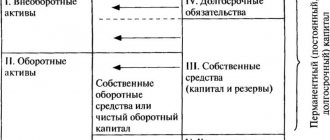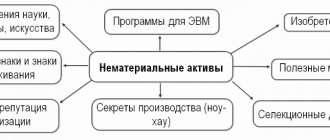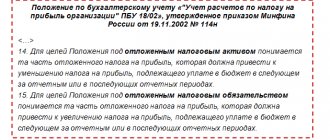Useful life (USL) is one of the key indicators that determines the amortization of an organization's intangible assets. At the same time, determining the PPI of an asset that does not have a material form, but is capable of bringing material benefits during operation, is often a problem. How to determine the SPI of a patent, business reputation, or company website, which regulations to use when determining the SPI and what to do if it is impossible to determine it for one reason or another - this is not a complete list of problems that practitioner accountants face in their daily work, when the matter concerns intangible assets. Let's consider the most significant aspects of accounting for intangible assets and determining their useful life.
What are intangible assets
From the name it follows that this is an asset devoid of a physical, tangible form. It can bring commercial benefits to the company and has been used by it for more than a year.
Examples of intangible assets:
- trademarks;
- literary, cultural, scientific works;
- business reputation;
- Internet resources of the company involved in the production process, etc.
The following do not apply to intangible assets: financial investments, organizational expenses incurred during the formation of a company, material media of intangible assets themselves (for example, flash drives containing software records).
SPI of intangible assets and legal framework
Acceptance of the specified objects for accounting entails the need to calculate the period during which they will be used. According to PBU 14/07 (Chapter IV), SPI is the period of time during which the company plans to use intangible assets in order to obtain financial benefits.
SPI is calculated monthly. The value of this indicator is influenced by the following factors:
- the period during which the company intends to use the intangible assets;
- the period during which the company has the rights to use the intangible asset or the transfer of control over it occurs.
If the properties of an asset do not make it possible to determine the period reliably, it is recognized as uncertain. Such an object is not subject to depreciation.
Attention! SPI cannot be less than 12 months old, otherwise the object does not meet the criteria for intangible assets (see PBU 14/07).
Business reputation is also an intangible asset. Any business reputation is amortized over a 20-year period (see PBU 14/07, clauses 43.44).
In tax accounting, SPI intangible assets begin to be calculated from the moment it is put into operation. It is necessary to take into account the validity periods of certificates, patents, and other restrictive documents (Article 258-2 of the Tax Code of the Russian Federation). It is advisable to take into account the specifics of contracts for certain intangible assets.
If it is not possible to reliably determine the SPI, the “10 years” indicator is used.
Firms are authorized to arbitrarily establish PPI of assets relating to exclusive rights:
- for programs, electronic databases;
- for an industrial model, sample, invention;
- on the use of integrated circuit configurations;
- for work in the field of selection;
- for know-how, secret technologies, formulas.
The period, according to the Tax Code, is set at two years and above.
GLAVBUKH-INFO
| Page 3 |
| Page 4 |
| Page 5 |
| Page 6 |
| Page 7 |
| All pages |
Page 6 of 7
Analysis of depreciation period and depreciation method
104. The amortization period and method of calculating amortization of an intangible asset with a finite useful life should be reviewed at least at the end of each financial year. If the expected useful life of a given asset differs from previous estimates, the depreciation period must be adjusted accordingly. If there is a change in the expected pattern of consumption of the future economic benefits embodied in the asset, the depreciation method must be changed to reflect the changed pattern. Such changes should be accounted for as changes in accounting estimates in accordance with IAS 8.
105. During the life of an intangible asset, it may become apparent that the estimate of its useful life is incorrect. For example, the recognition of an impairment loss may indicate that the amortization period needs to be changed.
106. Over time, the nature of the future economic benefits that an entity expects to receive from an intangible asset may change. For example, it may become apparent that it is more appropriate to calculate depreciation using the declining balance method rather than the straight-line method. Another example is where the exercise of the rights that are the subject of a license is delayed pending action on other components of the business plan. In this case, the receipt of economic benefits from the asset is deferred until later periods.
Intangible assets with an indefinite useful life__________________________________________________________
107. An intangible asset with an indefinite useful life is not subject to amortization.
108 IAS 36 requires an entity to test an indefinite-lived intangible asset for impairment by comparing its recoverable amount to its carrying amount.
(a) annually, and
(b) whenever there is an indication that the intangible asset may be impaired.
Useful life estimation analysis
109. The useful life of an intangible asset that is not subject to amortization shall be reviewed each period to determine whether events and circumstances continue to support the assessment of the asset's useful life as indefinite. If they do not support that estimate, then a change in the estimated useful life from indefinite to finite should be accounted for as a change in estimate in accordance with IAS 8.
110. According to IAS 36, a revision of the estimated useful life of an intangible asset from indefinite to finite is an indication that the asset may be impaired. As a result, the entity tests the asset for impairment by comparing its recoverable amount, determined in accordance with IAS 36, to its carrying amount and recognizing any excess of the carrying amount over the recoverable amount as an impairment loss.
Recoverability of carrying amount - impairment losses__________
111 An entity applies IAS 36 to test whether an intangible asset is impaired. This standard explains when and how an entity analyzes the carrying amount of its assets, how it determines the recoverable amount of an asset and when it recognizes or reverses an impairment loss.
Discontinuation and disposal________________________________
112. Recognition of an intangible asset is ceased:
(a) upon its disposal; or
(b) when no future economic benefits are expected from its use or disposal.
113. The gain or loss arising from the derecognition of an intangible asset is determined as the difference between the net proceeds on disposal, if any, and the carrying amount of the asset. They are recognized in profit or loss when the asset is derecognised (unless IAS 17 requires different requirements for sale and leaseback). Profits should not be classified as revenue.
114. The disposal of an intangible asset can take place in various cases (for example, as a result of a sale, a finance lease or a gift). In determining the date of disposal of such an asset, an entity applies the criteria set out in IAS 18 Revenue for recognizing revenue from the sale of goods. IAS 17 applies when the disposal occurs as a result of a sale and leaseback.
115 If, in accordance with the recognition principle set out in paragraph 21, an entity recognizes the cost of replacing part of an intangible asset as part of the carrying amount of an asset, it ceases to recognize the carrying amount of the replaced part. If it is impracticable for an entity to determine the carrying amount of the replaced part, it may use the cost of the replacement part as an indication of the value of the replaced part at the time it was acquired or generated internally.
115A. In the case of a reacquired right in a business combination, if the right is subsequently reissued (sold) to a third party, the relevant carrying amount, if any, shall be used in determining the gain or loss on the reissue.
116. Consideration to be received on disposal of an intangible asset is initially recognized at fair value. When payment for this intangible asset is deferred, the consideration received is initially recognized at the equivalent price, subject to immediate cash payment. The difference between the nominal amount of the consideration and the cash equivalent price if paid immediately is recognized as interest income in accordance with IAS 18, reflecting the effective yield of the receivable.
117 Amortization of an intangible asset with a finite useful life does not cease when the asset is no longer in use, unless the asset is already fully depreciated or classified as held for sale (or included in a disposal group classified as held for sale) in accordance with IFRSs ( IFRS) 5.
Information disclosure_______________________________________________
General provisions
118. An enterprise must disclose the following information for each class of intangible assets, distinguishing between self-created intangible assets and other intangible assets:
(a) whether the relevant assets have an indefinite or finite useful life and, if finite, the useful life or depreciation rates applied;
(b) the amortization methods used for intangible assets with finite useful lives;
(c) the gross carrying amount and any accumulated depreciation (combined with accumulated impairment losses) at the beginning and end of the relevant period;
(d) the line item(s) in the statement of comprehensive income that includes any amortization of intangible assets;
(e) a reconciliation of the carrying amount at the beginning and end of the relevant period, showing:
(i) proceeds, identifying separately those received as a result of internal developments, those acquired as separate assets and those acquired as part of business combinations;
(ii) assets classified as held for sale or included in a disposal group classified as held for sale in accordance with IFRS 5 and other disposals;
(iii) increases or decreases during the period resulting from revaluations in accordance with paragraphs 75, 85 and 86 and from impairment losses recognized or reversed directly in other comprehensive income in accordance with IAS 36 (if any take place);
(iv) impairment losses recognized in profit or loss during the period in accordance with IAS 36 (if any);
(v) impairment losses reversed to profit or loss during the period in accordance with IAS 36 (if any);
(vi) any depreciation recognized during the period;
(vii) net exchange differences arising when translating financial statements into the reporting currency, and when translating the figures of a foreign subsidiary into the reporting currency of the enterprise;
(viii) other changes in carrying amount during the period.
119. A class of intangible assets is a grouping of assets that are similar in nature and in the way they are used in the activities of an enterprise. Examples of individual classes include:
(a) trade names;
(b) title details and names of published publications;
(c) computer software;
(d) licenses and franchises;
(e) copyrights, patents and other industrial property rights, maintenance and operating rights;
(f) recipes, formulas, models, drawings and prototypes; And
(g) intangible assets under development.
The above classes are broken down into smaller classes (combined into larger classes) if this provides users of financial statements with more relevant information.
120 An entity discloses information about impaired intangible assets in accordance with IAS 36 in addition to the information required by paragraph 118(e)(iii)–(v).
121 IAS 8 requires an entity to disclose the nature and amount of any change in an accounting estimate that has a material effect in the current period or is expected to have a material effect in subsequent periods. Such disclosure may be necessary in connection with changes to:
(a) estimating the useful life of an intangible asset;
(b) the method of depreciation; or
(c) residual value.
122. An enterprise must also disclose the following information:
(a) in the case of an intangible asset classified as an indefinite-lived intangible asset, the carrying amount of that asset and the basis for its measurement as an indefinite-lived intangible asset. In disclosing such reasons, the entity must describe the factor or factors that significantly influenced the determination that the asset has an indefinite useful life.
(b) the description, carrying amount and remaining amortization period of any individual intangible asset that is material to the financial statements of the entity.
(c)for intangible assets acquired with a government grant and initially recognized at fair value (see paragraph 44):
(i) the fair value at which the assets were initially recognized;
(ii) their carrying amount;
(iii) whether they are measured after recognition using the cost model or the revalued cost model.
(d) the existence and carrying amount of intangible assets, the ownership of which is subject to certain restrictions, as well as the carrying amount of intangible assets pledged as security for obligations;
(e) the amount of obligations assumed under the contract to acquire intangible assets.
123 When an entity describes the factor or factors that played a significant role in determining that the useful life of an intangible asset is indefinite, the entity shall consider the list of factors in paragraph 90.
<< Previous — Next >>
| < Previous | Next > |
Accounting for SPI intangible assets
The value of assets is written off through depreciation based on their useful lives. To account for depreciation of intangible assets, account 05 is used, in correspondence with expense accounts.
In order to reduce labor costs, most companies prefer to use the straight-line depreciation method in both tax and accounting. When the useful life of intangible assets is more than two decades, only the linear method is used. Its calculation is determined by the formula:
k = 1/N * 100%
Where:
- k – annual depreciation rate;
- N – SPI.
The monthly rate is calculated by dividing by 12. There are other methods for calculating depreciation.
Accounting
Declining balance method - the residual value on the first date of the month is multiplied by the ratio of the acceleration factor (1-3) to the remaining useful life, expressed in months.
Volume method - based on the volume of production that is expected to be received during the entire use of the asset. The ratio of the actual value obtained for the month to the calculated value for the entire SPI is compiled. The result is multiplied by the initial cost of the intangible asset.
These costs are always taken into account during the period of their formation.
Attention! Goodwill is amortized only linearly.
Tax accounting
Nonlinear method, group. For depreciation groups, the total balance should be determined by the starting date of the month. This is the residual value of all assets in the group, depreciation for which is calculated using the specified method. Then we calculate the monthly depreciation amount for each group. The depreciation rate specified in Art. 259.2 of the Tax Code of the Russian Federation, clause 5 (from 14.3 to 0.7% in group 10), divided by 100. The resulting value is multiplied by the total group balance. Month after month, the total balance will decrease.
We present the calculation of depreciation of intangible assets linearly , since this method is most common in practice.
Let the initial cost of intangible assets be 250.0 thousand rubles. The SPI is determined by the company to be 5 years. The depreciation rate, according to the formula given above, is calculated at 20%. The monthly rate will be 1.67%. 250,000 * 1.67% = 4167.50 – monthly depreciation charges at the time of calculation.
IAS 38 INTANGIBLE ASSETS
18 To recognize an item as an intangible asset, an entity must demonstrate that the item meets:
(a) the definition of an intangible asset (see paragraphs - );
and (b) recognition criteria (see paragraphs - ).
This requirement applies to the initial costs of acquiring an intangible asset or creating it in-house and subsequent costs of improving it, partially replacing it or servicing it.
19 Paragraphs - discuss the application of recognition criteria to intangible assets acquired separately, and paragraphs - discuss the application of these criteria to intangible assets acquired in a business combination. The paragraph establishes the procedure for the initial assessment of intangible assets acquired with the help of a government subsidy, the paragraphs consider transactions for the exchange of intangible assets, and the paragraphs consider the accounting procedure for goodwill created within the organization. The paragraphs set out the principles for the initial recognition and assessment of intangible assets created by the organization itself.
20 The nature of intangible assets is such that in many cases, improvement or partial replacement of such assets is not carried out. Consequently, most subsequent costs are likely to provide the expected future economic benefits embodied in the existing intangible asset, but will not satisfy the definition of an intangible asset and the recognition criteria in this Standard. In addition, it is often difficult to attribute subsequent costs directly to a specific intangible asset rather than to the business as a whole. Thus, only rarely are subsequent costs—costs incurred after the initial recognition of an acquired intangible asset or after the entity completes its own creation of the intangible asset—recognized as part of the asset's carrying amount. Subsequent costs for trademarks, title data, publishing rights, customer bases and similar items (whether acquired or generated by the entity itself) are always recognized in profit or loss as incurred. This is due to the fact that such costs cannot be distinguished from the costs of business development as a whole.
21 An intangible asset is recognized if and only if:
(a) it is considered probable that the entity will receive future economic benefits associated with the item;
and (b) the cost of the asset can be measured reliably.
22 An entity shall estimate the probability of expected future economic benefits using reasonable and supportable assumptions that represent management's best estimate of the totality of economic conditions that will exist over the useful life of the asset.
23 An entity applies judgment to estimate the degree of certainty associated with the flow of future economic benefits from the use of an asset based on data available at the time of initial recognition, giving greater weight to data obtained from external sources.
24 An intangible asset is initially measured at cost.
Separate purchase
25 Typically, the price an entity pays to separately acquire an intangible asset reflects expectations about the likelihood that the entity will receive the future economic benefits embodied in that asset. That is, an entity expects an inflow of economic benefits even if there is uncertainty about the timing or magnitude of the inflow. Therefore, for separately acquired intangible assets, the probabilistic recognition criterion in paragraph (a) is always considered to be satisfied.
26 In addition, the cost of a separately acquired intangible asset can usually be measured reliably. This is particularly true where the consideration paid upon acquisition is in the form of cash or other monetary assets.
27 The cost of a separately acquired intangible asset includes:
(a) its purchase price, including import duties and non-refundable purchase taxes, after deducting trade discounts and rebates;
and (b) all costs directly attributable to preparing the asset for its intended use.
28 Examples of directly attributable costs are:
(a)employee benefit costs (as defined in IAS 19) directly attributable to bringing the asset to working condition;
(b) professional costs directly attributable to bringing the asset into working order; And(c) the cost of verifying the proper functioning of the asset.
29 Examples of costs that are not included in the actual cost of an intangible asset are:
(a) costs associated with promoting new products or services (including costs of advertising and promotional activities);
(b) costs associated with conducting business in a new location or with a new category of customers (including costs of training personnel); And(c) administrative and other general overhead costs.
30 Costs are ceased to be recognized in the carrying amount of an intangible asset when the asset is brought to a condition suitable for its use in accordance with management’s intentions. Consequently, costs incurred in using or relocating an intangible asset are not included in the carrying amount of that asset. For example, the following costs are not included in the carrying amount of an intangible asset:
(a) costs incurred while an asset capable of being used as intended by management has not yet been brought into service;
and (b) initial operating losses, such as operating losses incurred in generating demand for the outputs produced by the asset.
31 Some transactions occur in connection with the development of an intangible asset, but are not necessary to bring the asset to a condition suitable for its use in accordance with management's intentions. These side activities can take place both before and during development. Because incidental transactions are not necessary to bring the asset to a condition suitable for its use in accordance with management's intentions, income and expenses on incidental transactions should be recognized immediately when incurred in profit or loss and included in the appropriate categories of income and expense.
32 If the deferred payment for an intangible asset extends beyond normal lending terms, the original cost of such an asset is equal to the equivalent price if paid immediately in cash. The difference between this amount and the total payments is recognized as interest expense over the life of the loan unless it is capitalized in accordance with IAS 23 Borrowing Costs.
Acquisition as part of a business combination
33 In accordance with IFRS 3 Business Combinations, if an intangible asset is acquired in a business combination, the cost of the intangible asset is its fair value at the acquisition date. The fair value of an intangible asset will reflect market participants' expectations at the acquisition date regarding the likelihood that the entity will receive the future economic benefits embodied in the asset. In other words, an entity expects to receive economic benefits even if there is uncertainty about the timing and amount of those economic benefits. Therefore, for intangible assets acquired in business combinations, the probabilistic recognition criterion in paragraph (a) is always considered to be met. If the asset acquired in a business combination is separable or arises from contractual or other legal rights, sufficient information exists to make a reliable estimate of the fair value of the asset. Therefore, for intangible assets acquired in business combinations, the reliable measurement criterion in paragraph (b) is always considered to be met.
34 In accordance with this Standard and IFRS 3 (as revised 2008), the acquirer recognizes the acquiree's intangible asset separately from goodwill at the acquisition date, regardless of whether the acquiree recognized that asset before the business combination. This means that the acquirer recognizes as an asset, separate from goodwill, the acquiree's in-progress research and development project if the project meets the definition of an intangible asset. An acquiree's research and development organization's work in progress meets the definition of an intangible asset when it:
(a) meets the definition of an asset;
and (b) is identifiable, i.e. is severable or arises from contractual or other legal rights.
Intangible asset acquired in a business combination
35 If an intangible asset acquired in a business combination is separable or arises from contractual or other legal rights, sufficient information exists to make a reliable estimate of the fair value of the asset. For estimates used to estimate the fair value of an intangible asset, if there is a range of possible outcomes with varying degrees of probability, then this uncertainty is a factor taken into account in estimating fair value.
36 An intangible asset acquired in a business combination may be severable, but only together with any related contract, identifiable asset or liability. In such cases, the acquirer recognizes the intangible asset separately from goodwill, but together with an accompanying item.
37 An acquirer may recognize a group of complementary intangible assets as a single asset provided that the individual assets in the group have similar useful lives. For example, the terms “trademark” and “trade name” are often used interchangeably with trademarks and other marks. However, the former are general marketing terms that are typically used to refer to a group of complementary assets, such as a trademark (or service mark) and its associated trade name, formulas, recipes and expertise.
38 - 41 [Deleted]
Subsequent costs in relation to an acquired in-progress R&D project
42 Research and development costs that:
(a) relates to an unfinished research and development project acquired separately or in a business combination and recognized as an intangible asset;
and (b) arise after the acquisition of such a project shall be accounted for in accordance with paragraphs - .
43 Application of the requirements in paragraphs means that subsequent costs for an unfinished research and development project acquired separately or in a business combination and recognized as an intangible asset:
(a) are recognized as expenses when incurred if the costs are research costs;
(b) are recognized as an expense when incurred if the costs are development costs that do not meet the criteria for recognition as an intangible asset in paragraph ; And(c)increase the carrying amount of an acquired research and development project in progress if it is development expenditure that meets the recognition criteria in paragraph .
Purchase through government subsidy
44 In some cases, the acquisition of an intangible asset may involve no payment or may involve nominal consideration if the acquisition is supported by a government grant. This may occur when a government transfers or allocates intangible assets to an organization, such as airport landing rights, radio and television licenses, import licenses or quotas, or rights to access other scarce resources. Under IAS 20 Accounting for Government Grants and Disclosure of Government Assistance, an entity may initially recognize both the intangible asset and the grant at their fair value. If, at the entity's election, an asset is not initially recognized at fair value, the entity recognizes the asset at its nominal amount (the alternative accounting permitted by IAS 20) plus the amount of costs directly attributable to preparing the asset for its intended use.
Asset exchange
45 One or more intangible assets may be acquired by exchange for a non-monetary asset or assets, or some combination of monetary and non-monetary assets. The following considerations apply to the simple exchange of one non-monetary asset for another, but they also apply to all exchanges specified in the previous sentence. The cost of such an intangible asset is measured at fair value unless: (a) the exchange transaction lacks commercial substance, or (b) the fair value of either the asset received or the asset given up cannot be measured reliably. The acquired asset is measured in this way even if the entity cannot immediately derecognise the transferred asset. If the acquired asset is not measured at fair value, then its initial cost is measured at the carrying amount of the asset transferred.
46 An entity determines whether an exchange transaction has commercial substance by assessing the extent to which future cash flows are expected to change as a result of the transaction. An exchange operation has commercial content if:
(a) the structural parameters (risk, timing and magnitude) of the cash flows on the received asset differ from the structural parameters of the cash flows on the transferred asset;
or (b) as a result of such exchange, the inherent value of the entity of that part of its activities affected by the transaction changes; And(c) the difference in (a) or (b) is significant in relation to the fair value of the assets exchanged.
For the purpose of determining whether an exchange transaction has commercial substance, the entity's inherent value of the portion of its activities affected by the transaction must reflect after-tax cash flows. The result of this analysis may be obvious even without the organization performing detailed calculations.
47 Paragraph (b) requires that an intangible asset be recognized reliably if its cost can be measured reliably. The fair value of an intangible asset can be measured reliably if (a) the range over which reasonable estimates of fair value vary is not significant for the asset or (b) the probability of different estimates within those ranges can be reasonably estimated and used in estimating fair value. If an entity is able to measure reliably the fair value of the asset received or the asset given up, the fair value of the asset given up is used as the basis for measuring the value unless the fair value of the asset received is more readily apparent.
Goodwill generated internally
48 Goodwill generated internally is not recognized as an asset.
49 In some cases, expenditures are incurred to create future economic benefits but do not result in the creation of an intangible asset that meets the recognition criteria of this Standard. Such costs are often referred to as costs that contribute to the generation of internally generated goodwill. Goodwill generated internally by an entity is not recognized as an asset because it is not an identifiable resource (that is, it is not separable and does not arise from contractual or other legal rights) that is controlled by the entity and can be measured reliably at cost.
50 Differences between an entity's fair value and the carrying amount of its identifiable net assets at any time can be attributed to a number of factors that affect the entity's fair value. However, such differences do not represent the historical cost of the intangible assets controlled by the entity.
Intangible assets created by the organization itself
51 It is sometimes difficult to assess whether an independently created intangible asset meets the criteria for recognition due to problems associated with:
(a) determining the existence and timing of an identifiable asset that will produce expected future economic benefits;
and (b) a reliable determination of the historical cost of assets. In some cases, the costs of creating an intangible asset by the organization itself cannot be distinguished from the costs of maintaining or increasing goodwill generated within the organization or of carrying out day-to-day activities.
Therefore, in addition to complying with the general requirements for the recognition and initial measurement of an intangible asset, the organization applies the requirements and guidance of paragraphs to all intangible assets created by the organization itself.
52 To assess whether an intangible asset independently created by an organization meets the recognition criteria, an organization divides the process of creating an asset into two stages:
(a) stage of research;
and (b) development stage.
Although the terms "research" and "development" are defined, the terms "research stage" and "development stage" have a broader meaning in the context of this standard.
53 If, as part of an internal project aimed at creating an intangible asset, the organization is unable to separate the research phase from the development phase, then the organization accounts for the costs of such a project as if they were incurred only during the research phase.
Research stage
54 No intangible asset resulting from research (or the research phase of an internal project) is recognized. Research costs (or the research phase of an internal project) are recognized as expenses when incurred.
55 At the research stage of an internal project, an organization cannot demonstrate the existence of an intangible asset that will generate probable future economic benefits. Consequently, related costs are recognized as expenses when incurred.
56 Examples of research activities are:
(a) activities aimed at obtaining new knowledge;
(b) searching, evaluating and finalizing applications of research results or other knowledge;(c) seeking alternative materials, devices, products, processes, systems or services; And
(d) the formulation, design, evaluation and final selection of possible alternatives to new or improved materials, devices, products, processes, systems or services.
Development stage
57 An intangible asset resulting from development (or the development phase of an internal project) shall be recognized if and only if the entity can demonstrate all of the following:
(a) the technical feasibility of completing the development of the intangible asset and bringing it to a condition suitable for use or sale;
(b) its intention to complete development of the intangible asset and to use or sell it;(c) the ability to use or sell the intangible asset;
(d) the expected manner in which likely future economic benefits will be achieved. Among other things, the entity may demonstrate the existence of a market for the product derived from the use of the intangible asset, or the intangible asset itself, or, if the asset is intended for internal use by the entity, the utility of the intangible asset;
(e) the availability of sufficient technical, financial and other resources necessary to complete the development and use or sale of the intangible asset;
(f) the ability to reliably measure the costs associated with the intangible asset during its development.
58 In some cases, an organization may be able to identify an intangible asset during the development stage of an internal project and demonstrate that the asset will generate probable future economic benefits. This is because the project development stage is more advanced than the research stage.
59 Examples of development activities are:
(a) designing, constructing and testing prototypes and models before production or use;
(b) design of tools, templates, molds and dies involving new technology;(c) design, construction and operation of a pilot plant that is not economically feasible for commercial production; And
(d) design, construction and testing of selected alternatives to new or improved materials, devices, products, processes, systems or services.
60 To demonstrate how an intangible asset will generate probable future economic benefits, an entity estimates the future economic benefits to be derived from the asset using the principles of IAS 36 Impairment of Assets. If an asset will generate economic benefits only in combination with other assets, the entity applies the concept of IAS 36 for cash-generating units.
61 The availability of resources to complete the creation, use and benefits of an intangible asset can be demonstrated, for example, by the existence of a business plan showing the technical, financial and other resources required and the organization's ability to provide those resources. In some cases, an organization demonstrates the possibility of using external financing by obtaining confirmation from the lender of its readiness to finance the activities provided for in the business plan.
62 An organization's costing systems often provide a reliable estimate of the costs of creating an intangible asset in-house, such as wages and other costs incurred in obtaining copyrights or licenses or in developing computer programs.
63 Trademarks, title data, publishing rights, customer bases and essentially similar items created by the organization itself are not subject to recognition as intangible assets.
64 Costs for trademarks, title data, publishing rights, customer bases and similar items created by the organization itself cannot be distinguished from the costs of developing the business as a whole. Consequently, such items are not subject to recognition as intangible assets.
The initial cost of intangible assets created by the organization itself
65 In relation to paragraph, the initial cost of an intangible asset created by the organization itself is equal to the amount of costs incurred from the date on which the intangible asset first met the recognition criteria specified in paragraphs , and . The clause prohibits the recovery of costs that have already been recognized as expenses.
66 The initial cost of an intangible asset created by the organization itself includes all costs directly associated with the creation, production and preparation of this asset for use in accordance with management's intentions. Examples of directly attributable costs are:
(a) the costs of materials and services used or consumed in creating the intangible asset;
(b)employee benefit costs (as defined in IAS 19) arising in connection with the creation of the intangible asset;(c) payments necessary to register a legal right; And
(d) amortization of patents and licenses used to create the intangible asset.
IAS 23 sets out criteria for recognizing interest as an element of the cost of an entity's own generated intangible asset.
67 The initial cost of an intangible asset created by the organization itself does not include the following costs:
(a) selling, administrative and other general overhead costs other than those that can be attributed directly to preparing the asset for use;
(b) identified inefficiencies and initial operating losses incurred before the specified asset achieved its planned performance; And(c) the cost of training personnel to operate the asset.
Example to illustrate the point
An organization is developing a new production process. In 20X5 costs incurred were CU1,000, of which CU900 arose before 1 December 20X5 and CU100 - during the period from 1 December 20X5 to 31 December 20X5. An entity can demonstrate that at 1 December 20X5 the production process met the criteria for recognition as an intangible asset. The recoverable amount of the know-how embodied in the process (taking into account future cash outflows to complete the process so that it can be used) is CU500.At the end of 20X5, the production process is recognized as an intangible asset at cost of CU100 (costs incurred from the date the intangible asset first qualified for recognition, ie 1 December 20X5). Costs of CU900 incurred before 1 December 20X5 are recognized as an expense because the recognition criteria were not met before 1 December 20X5. These costs are not included in production process costs reflected in the statement of financial position.
In 20X6 costs incurred were CU2,000. At the end of 20X6, the recoverable amount of the know-how embodied in the process (taking into account future cash outflows to complete the process so that it can be used) was estimated to be CU1,900.
At the end of 20X6, production process costs are CU2,100. (CU100 cost recognized at the end of 20X5 plus CU2,000 cost recognized in 20X6). The entity recognizes an impairment loss of CU200. to adjust the original (before the impairment loss) carrying amount of the process (CU2,100) to its recoverable amount (CU1,900). This impairment loss will be reversed in a subsequent period if the requirements in IAS 36 for the reversal of an impairment loss are met.
——————————— In this standard, monetary amounts are expressed in “monetary units (CU)”.
Useful life of intangible assets in questions and answers
Can the useful life change during the operation of intangible assets?
Yes. The company is obliged to check accounting data for intangible assets every year and, if necessary, adjust the deadline to reflect any deviations that have arisen.
Is it necessary to check accounting data for assets with a previously undefined period?
Yes, it is necessary on a general basis.
Is it possible to revise the terms of use of intangible assets at NU?
No, the deadlines are fixed and cannot be revised.
How to determine the SPI of a company website?
In most cases, the site's PPI is not reflected in the documents. A company can set such a deadline independently, reflecting it in internal orders or local NAs. You need to be prepared for claims from the Federal Tax Service. The inspection may require recognition of the impossibility of establishing the actual SPI of the resource and use a period of 10 years for NU purposes. However, the position of the fiscal authorities is not indisputable.
How is depreciation calculated on intangible assets of non-profit organizations?
Such assets owned by non-profit organizations are not subject to depreciation.
T.I. Yurkova, S.V. Yurkov Enterprise economyElectronic textbook, 2006
Previous
| Table of contents | Next |
MODULE 3.4. DEPRECIATION OF INTANGIBLE ASSETS
Intangible assets are accounted for in the balance sheet at their residual value. The cost of intangible assets is repaid by calculating depreciation over the established period of their useful life. Depreciation charges are made in one of the following ways: · linear method based on the standards calculated by the organization based on their useful life; · reducing balance method; · the method of writing off the cost in proportion to the volume of products (works, services).
The application of one of the methods for a group of homogeneous intangible assets is carried out throughout their entire useful life.
During the useful life of intangible assets, the accrual of depreciation charges is not suspended, except in cases of conservation of the organization.
The annual amount of depreciation charges under the straight-line method is determined on the basis of the initial cost of intangible assets and the depreciation rate calculated based on the useful life of this object. With the reducing balance method, the amount of depreciation for the year is calculated based on the residual value of intangible assets at the beginning of the reporting year and the depreciation rate calculated based on the useful life of this object.
During the reporting year, depreciation charges on intangible assets are accrued monthly, regardless of the calculation method used, in the amount of 1/12 of the annual amount.
When writing off the cost in proportion to the volume of products (works), depreciation charges are calculated depending on the natural indicator of the volume of products (works) in the reporting period and the ratio of the initial cost of the intangible asset and the estimated volume of products (works) for the entire useful life of this object.
The useful life of intangible assets is determined by the organization when accepting the object for accounting. The useful life is the period during which the use of an object brings profit and benefit to the enterprise.
The useful life for patents, licenses, rights of use, and so on is the period specified in the contract.
For intangible assets for which it is difficult or impossible to determine the useful life, depreciation rates are established based on a conditional period (but not longer than the life of the organization).
In Russia, this period is 20 years of continuous operation. In China, the useful life in similar cases is 10 years. In the United States, in such situations, it is customary to focus on the so-called reasonable period, not exceeding 40 years.
Depreciation is not accrued for intangible assets received under a gift agreement and free of charge during the privatization process, acquired using budgetary allocations, and intangible assets of budget organizations.
It is possible not to charge depreciation charges for certain types of intangible assets, the list of which the enterprise establishes independently. Typically these include assets whose value does not decrease over the years (for example, trademarks).
Depreciation charges for intangible assets begin on the first day of the month following the month in which this object was accepted for accounting, and are accrued until the cost of this object is fully repaid or this object is retired from accounting. Depreciation charges for intangible assets cease from the first day of the month following the month of full repayment of the cost of this object or write-off of this object from accounting.
Test control
1. Is it possible to evaluate intangible assets at residual value? 2. In what cases does it make sense to refuse to depreciate an intangible asset? 3. If it is impossible to determine the useful life of an intangible asset
| Previous | Table of contents | Next |
Material provided by the site AUP.Ru (Electronic library of economic and business literature)
Related materials: Debt amortization, mortgage loans, changes in financial contracts Amortization groups (subgroups). Features of including depreciable property in depreciation groups (subgroups) - Article 258 of the Tax Code of the Russian Federation Amnesty Depreciation of fixed assets Depreciation of fixed assets (Frolova T.A., 2009) Depreciable property









